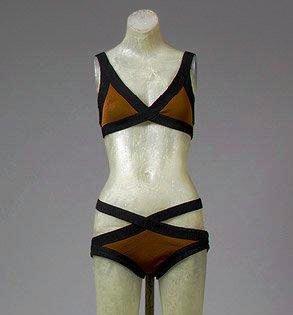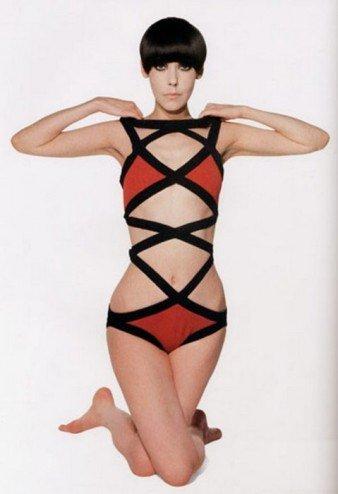
Although Rudi Gernreich is listed on ‘All-TIME 100 Fashion Icons’, his name is not as well-known as Dior, Balenciaga or Courréges. Perhaps because of his geographic detachment from the centers of fashion and the fact that he refused to show in Paris, but Rudi Gernreich had just as much influence on women’s appearance, especially during the 1960s and 1970s.
Rudolph (Rudi) Gernreich was born in Vienna, Austria, in 1922. His father was a hosiery manufacturer and his aunt kept a dress shop in which Rudi worked as a teenager. In 1938 with numerous other refugees, Rudi fled to the USA and settled in California. From 1942 to 1948 he worked with a dance troupe as a dancer and costume designer. In 1948, he became a freelance fashion designer. He toiled (to make the first garment in white cotton, before the pattern becomes definitive and goes in production) for a 7th Avenue firm making copies of Paris couture garments but really hated it. In 1951, he formed a partnership with manufacturer Walter Bass to supply clothes to Jax, a Los Angeles boutique.
Some years later, he opened his own company G.R. Designs Inc. which became named Rudi Gernreich Inc in 1964. Being a dancer himself, Rudi was interested in liberating the body from the limitations of clothing surfaced in his early swimwear designs of 1952 in which he eliminated the complicated boned and underpinned interior construction that had been obligatory in the 1950s. He revived the knitted swimsuit or ‘maillot’ of the 1920s, which he elasticized to follow the shape of the body. These experiments were continued in his knitted tube dresses of 1953. He was awarded the prestigious Coty Award for American designers in 1960. In the early 1960s Rudi opened a Seventh Avenue showroom in New York where he showed his popular designs for Harmon knitwear and his own more expensive line of experimental garments.
During the decade Rudi Gernreich acquired a reputation for being the most radical designer in America; his designs included the jacket with one notched and one rounded lapel, tuxedos made of white satin, and the topless bathing suit’ named Monokini of 1964, which reflected the new vogue for topless sunbathing. It was worn by Peggy Moffitt, his favourite model.
Rudi Gernreich’s freeing of the breasts was a social statement, somehow part of the emancipation of women, and a portent of the unfettering of the breast by the women’s movement in the 1970s. Rudi invented the ‘no bra’ bra in 1964, a soft nylon bra with no padding or boning in which breasts assumed their natural shape, rather than being molded into an aesthetic ideal. This kind of bra was later traded in again for boned and padded ones, because it didn’t do much good for breasts in the long ran…..
Rudi was the first to design unisex/interchangeable clothes for men and women such as floor-length kaftans or white knit bell-bottomed trousers and matching black and white midriff tops, and even, in 1975, Y-front underwear for women. Other designs included the first chiffon t-shirt dress, see-through blouses, coordinated outfits of dresses, handbags, hats and stockings known as the Total Look, mini dresses inset with clear vinyl stripes and the thong bathing suit, cut high to expose the buttocks. He experimented constantly with the potentials of different materials using cutouts, vinyl and plastic, and mixing patterns such as checks with dots.




Rudi was interested less in the details and decorations of clothes and more in how they looked in motion. In the 1950s he was designing relaxed, comfortable clothes fabricated out of wool, jersey, and other malleable materials, usually in solid colors or geometric shapes and checks. During the next decade he went on to use unusual fabrics and bold color disharmonies such as orange and blue or red and purple.

In 1964 corset manufacturers Warner Brothers Co., commissioned Rudi to design a bodystocking made of flesh coloured stretch nylon. He was quite creative, he did leggings, designed furniture, stockings, even gourmet soups, as well as clothing for children and menswear.His boxer shorts for women predated the 80’s version by about 8 years. In 1971 he had a Military look collection and showroom models carried rifles. At the time the Viet Nam war was going on.
.
Rudi Gernreich designs

Peggy Moffitt : ‘He seamed to be 30 years ahead of time. Rudi Gernreich is a widely misunderstood fashion prophet….’
His notion of freeing the body was taken to its logical extreme in his last design statement, the pubikini, which appeared in 1982, revealing the model’s dyed and shaped pubic hair.
.
In the USA, Rudi Gernreich was an influential co-founder of the Mattachine Society, the USA’s first gay liberation movement.
Rudi Gernreich died in 1985. In 1992, his favourite model Peggy Moffitt and her husband photographer William Claxton collaborated and published a book called ‘The Rudi Gernreich Book’ detailing all the fashion ideas of Gernreich and his wonderful clothes. She explained that he was a widely misunderstood fashion prophet, who came up with all today’s trends yesterday. In the year 2000, the city of New York decided to honour American fashion designers by placing bronze plaques along 7th Avenue, the great street of fashion in New York. This has been called the “FASHION WALK OF FAME.” Rudi Gernreich was one of those honoured.

.
Rudi Gernreich’s legacy, which was celebrated with an exhibit at MOCA in Los Angeles, hasn’t been forgotten and their will be a relaunch. Most information is still a mystery, but the man backing the business venture is a ‘German entrepreneur’ and while the global trademark rights have been obtained, the brand is still in need of a designer. The first runway show is expected in 2014….
.
(Almost all pictures in this post are made by William Claxton)
Next week: Peggy Moffitt































I sat in cafes in Bond Street in the 60s the most beautiful and fashionable women wore Russia fashion including frontless halter neck topless dresses yet to this day even talking to people in fashion they do not believe me nor are they aware of this designer , which is a shame and an error as I feel he was instrumental in leading design and change during his years in fashion a lost icon of design he needs exposure even today to expose his huge importance.